It’s benchmark time again. Towards Maturity’s Laura Overton gives us some evidence-based insight into how to navigate L&D through these uncertain times.
Today’s business landscape is very different from the one we had 10-15 years ago. It’s what is called a VUCA (volatile, uncertain, complex, ambiguous) world. In all likelihood, there will be many more changes and uncertainties in the next 10-15 years, leading to another new business landscape.
This has a huge impact on how L&D builds its strategic focus and delivers it to the business. It is essential that L&D plans its strategy around the concept of a VUCA world. In our recent research, 2014-15 Towards Maturity Benchmark Study, Modernising Learning, Delivering Results, we are starting to understand how L&D leaders are adapting their strategy in this VUCA business environment, exploring what they are doing, what their focus is, what is working and what isn’t.
What did we find? We found that an L&D strategy that focuses on critical outputs rather than inputs, on business imperatives and business alignment is the most likely to succeed. It’s the L&D strategy which is most in tune with its organisation’s overall strategy. This alignment boosts performance, productivity, time to competency, reduces attrition and so on. These are the results that L&D wants and the business wants. It’s what we call a modernised learning strategy, one that has the business, outcomes and performance at its core.
Aligning L&D strategy with business strategy is key to success. Those companies that are doing it reap the rewards, as the following statistics demonstrate:
- 13x more likely to report increased revenue
- 9x more likely to report increased productivity
- 5x more likely to report improved customer satisfaction as a benefit
- 50% more likely to have noticed positive changes in staff behaviour
In order to achieve this alignment, L&D needs a lot of clear, focused evidence. As business increasingly uses data to drive development and maintain a competitive edge, L&D too needs to use data to inform, drive and communicate its decision making. Data is key, so L&D needs to gather as much meaningful data as it can – data about the business, about learners and about performance.
Learning analytics are an invaluable internal resource. They provide information on what employees are learning, when they are learning it and what their learning preferences are. An external resource that is also invaluable is performance benchmarking – this provides robust, genuine evidence on L&D’s performance, the effectiveness and impact of the learning process.
By using all of this evidence, L&D can really focus its strategy and learning interventions on what best suits the business and the modern learner. All these tools are out there – L&D must take advantage of them if they are to be strategic business partners.
However, what we have found is that L&D is not making best use of the data services available or even the data that they have. The following statistics tell a story:
- Of those with an LMS, 33% are using learning analytics to create more efficient and effective learning environments, compared with 52% in top learning companies
- 21% are using learning analytics to improve the service they offer, compared with 54% in top performing learning companies
- 23% actively benchmark their learning strategy and practices against others in their industry, compared with 41% of top learning companies
- 17% actively use benchmarking as a performance improvement, compared with 35% of top learning companies.
To respond appropriately and rapidly to change, L&D needs to become much more evidence-based and make the most of the data that is available. Constant data gathering and updating of information enables L&D to keep on track of business needs and where the business is heading. This ties into another critical area of a modernised learning strategy: learning at the point of need.
In this agile, constantly changing and complex world, it is essential that employees can access learning at the point of need, not three months later when it’s too late. Many employees are already doing this, under their own steam, due to all the technologies now available. L&D needs to focus its efforts on ensuring it knows what the learning needs of its workforce are now, what future learning needs are likely to be and how to provide the right learning for employees or signpost them in the right direction. According to our 2014-15 survey, 47% of participants agree that learning is delivered in time to meet the needs of the business.
On-demand learning enables organisations to keep abreast of change, to be agile and innovative. That requires L&D to be an agent of change. It needs to ensure the business has the right skills at the right time. Our survey found that learning innovation continues to deliver significant results, with participants reporting:
- 14% improvement in productivity
- 23% improvement in speed of rollout of new products/services
- 12% reduction in time to proven competency
- 9% reduction in attrition rates
- but only 15% of participants measure specific KPIs when evaluating effectiveness
L&D needs to have a really focused talent management strategy that encompasses current and future skills and capabilities. Again, it comes back to business alignment – knowing what the business needs and how to provide it.
Laura Overton is managing director of Towards Maturity. How does your strategy compare with the top performing L&D teams? The Towards Maturity 2015 Benchmark is now open, click here to start yours now
It's benchmark time again. Towards Maturity's Laura Overton gives us some evidence-based insight into how to navigate L&D through these uncertain times.
Today’s business landscape is very different from the one we had 10-15 years ago. It’s what is called a VUCA (volatile, uncertain, complex, ambiguous) world. In all likelihood, there will be many more changes and uncertainties in the next 10-15 years, leading to another new business landscape.
This has a huge impact on how L&D builds its strategic focus and delivers it to the business. It is essential that L&D plans its strategy around the concept of a VUCA world. In our recent research, 2014-15 Towards Maturity Benchmark Study, Modernising Learning, Delivering Results, we are starting to understand how L&D leaders are adapting their strategy in this VUCA business environment, exploring what they are doing, what their focus is, what is working and what isn’t.
What did we find? We found that an L&D strategy that focuses on critical outputs rather than inputs, on business imperatives and business alignment is the most likely to succeed. It’s the L&D strategy which is most in tune with its organisation’s overall strategy. This alignment boosts performance, productivity, time to competency, reduces attrition and so on. These are the results that L&D wants and the business wants. It’s what we call a modernised learning strategy, one that has the business, outcomes and performance at its core.
Aligning L&D strategy with business strategy is key to success. Those companies that are doing it reap the rewards, as the following statistics demonstrate:
- 13x more likely to report increased revenue
- 9x more likely to report increased productivity
- 5x more likely to report improved customer satisfaction as a benefit
- 50% more likely to have noticed positive changes in staff behaviour
In order to achieve this alignment, L&D needs a lot of clear, focused evidence. As business increasingly uses data to drive development and maintain a competitive edge, L&D too needs to use data to inform, drive and communicate its decision making. Data is key, so L&D needs to gather as much meaningful data as it can - data about the business, about learners and about performance.
Learning analytics are an invaluable internal resource. They provide information on what employees are learning, when they are learning it and what their learning preferences are. An external resource that is also invaluable is performance benchmarking – this provides robust, genuine evidence on L&D’s performance, the effectiveness and impact of the learning process.
By using all of this evidence, L&D can really focus its strategy and learning interventions on what best suits the business and the modern learner. All these tools are out there - L&D must take advantage of them if they are to be strategic business partners.
However, what we have found is that L&D is not making best use of the data services available or even the data that they have. The following statistics tell a story:
- Of those with an LMS, 33% are using learning analytics to create more efficient and effective learning environments, compared with 52% in top learning companies
- 21% are using learning analytics to improve the service they offer, compared with 54% in top performing learning companies
- 23% actively benchmark their learning strategy and practices against others in their industry, compared with 41% of top learning companies
- 17% actively use benchmarking as a performance improvement, compared with 35% of top learning companies.
To respond appropriately and rapidly to change, L&D needs to become much more evidence-based and make the most of the data that is available. Constant data gathering and updating of information enables L&D to keep on track of business needs and where the business is heading. This ties into another critical area of a modernised learning strategy: learning at the point of need.
In this agile, constantly changing and complex world, it is essential that employees can access learning at the point of need, not three months later when it’s too late. Many employees are already doing this, under their own steam, due to all the technologies now available. L&D needs to focus its efforts on ensuring it knows what the learning needs of its workforce are now, what future learning needs are likely to be and how to provide the right learning for employees or signpost them in the right direction. According to our 2014-15 survey, 47% of participants agree that learning is delivered in time to meet the needs of the business.
On-demand learning enables organisations to keep abreast of change, to be agile and innovative. That requires L&D to be an agent of change. It needs to ensure the business has the right skills at the right time. Our survey found that learning innovation continues to deliver significant results, with participants reporting:
- 14% improvement in productivity
- 23% improvement in speed of rollout of new products/services
- 12% reduction in time to proven competency
- 9% reduction in attrition rates
- but only 15% of participants measure specific KPIs when evaluating effectiveness
L&D needs to have a really focused talent management strategy that encompasses current and future skills and capabilities. Again, it comes back to business alignment – knowing what the business needs and how to provide it.
Laura Overton is managing director of Towards Maturity. How does your strategy compare with the top performing L&D teams? The Towards Maturity 2015 Benchmark is now open, click here to start yours now








